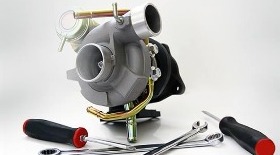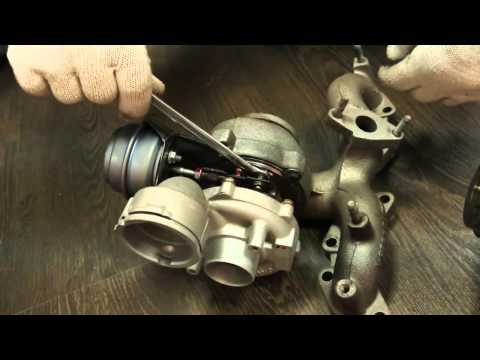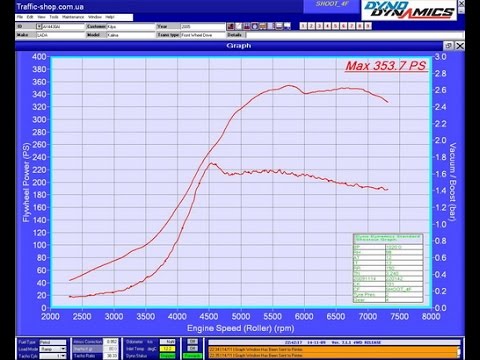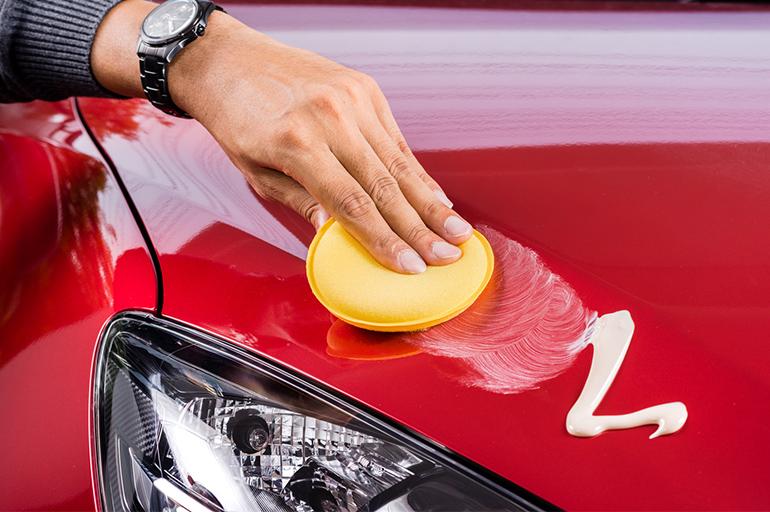
How to check a turbine
Content
There are a number of basic methods how to check the turbineto assess the condition of the unit. To do this, you do not need to use additional equipment, it is enough to visually, by ear and by touch assess the condition of individual elements of the turbine. The skills to test turbines for a diesel or gasoline ICE will be especially useful for those who plan to buy a used car with a turbocharged engine or this part for disassembly.
How to understand that the turbine is dying
Many modern cars, especially German-made ones (Volkswagen, AUDI, Mercedes and BMW) are equipped with turbocharged internal combustion engines. When buying a used car, it is imperative to check its individual components, namely, the turbine. Let us briefly list the signs that clearly indicate that the turbine is partially or completely out of order and needs to be repaired or replaced.
- very high operating noise, especially on a cold internal combustion engine;
- low acceleration dynamics;
- high oil consumption;
- oily cooler and pipes;
- black smoke from the exhaust pipe;
- the cooler staggers in its seat.

turbine failure. How to troubleshoot?
Useful recommendations for troubleshooting a breakdown of a car's internal combustion engine turbine. 3 common causes of turbine failure and the main signs of turbocharger failure. And also how to eliminate them Read more
Often, with a partial failure of the turbine, the warning light on the Check Engine dashboard is activated. Accordingly, you need to connect an error scanner and read information from the electronic control unit in order to carry out repair actions in the future.
Checking the state of the turbine on the internal combustion engine
Before moving on to the methods for testing a turbocharged internal combustion engine, it should be noted that the turbine itself is a simple, but rather expensive device. Installing the cheapest original unit on a German car will cost the owner at least 50 thousand Russian rubles. If you put not the original, but an analogue, then one and a half to two times cheaper. Accordingly, if during the verification process it turns out that the turbine has defects or does not work at all, it is worth starting a conversation with the owner of the car about reducing the total price of the car.
The sound of a faulty turbine
The simplest, but relative test is to listen to how it works. Moreover, it is necessary to listen to it “in the cold”, for example, after a cold night. It is in this state that the faulty unit will manifest itself "in all its glory." If the turbo is significantly worn, the bearing and cooler will make very loud whirring and/or grinding noises. The turbine bearing wears out quickly enough and makes unpleasant sounds. And the cooler will scrape the body with its blades. Accordingly, if sounds come from the turbine, it is better to refuse to buy a car, or ask to reduce the price by the cost of a new turbine.
Checking on a running engine
Checking the turbocharger on a running internal combustion engine allows you to understand whether the unit is working at all, and how much pressure it produces. This requires an assistant. The verification algorithm will be as follows:
- the assistant starts the internal combustion engine in neutral gear;
- the auto-amateur pinches the pipe connecting the intake manifold and the turbocharger with his fingers;
- the assistant presses the accelerator pedal several times in order for the turbine to give out excess pressure.
If the turbine is in a more or less normal state, then significant pressure will be felt in the corresponding pipe. If the nozzle does not swell and can be squeezed by hand, then this means that the turbine is partially or even completely out of order.
However, in this case, the problem may not be in the turbine, but in the presence of cracks in the pipe or in the intake manifold. Accordingly, such a check allows you to determine the tightness of the system.
Acceleration dynamics
The turbine itself is designed to increase power, and namely, in order to increase the dynamic characteristics of the car. Accordingly, with a working turbine, the car will accelerate very well and quickly. To test a turbocharged internal combustion engine, you need to get behind the wheel of a car and, as they say, press the gas pedal to the floor. For example, a turbocharged gasoline internal combustion engine with a volume of about two liters and a power of about 180 horsepower accelerates to 100 km / h in about 7 ... 8 seconds. If the power is not so high, for example, 80 ... 90 horsepower, then, of course, you should not expect such dynamics. But in this case, with a faulty turbine, the car will barely drive and accelerate. That is, be that as it may, the dynamics with a working turbine is felt by itself.
Internal combustion engine oil
With a faulty turbine, the oil quickly turns black and thickens. Accordingly, in order to check this, you need to unscrew the oil filler cap and assess the condition of the engine oil. It is best to use a flashlight for this (for example, on the phone). If the oil itself is black and thick, and oil clots are visible on the crankcase walls, then it is better to refuse to buy such a car, since further operation will require expensive repairs.
Turbine oil consumption
Any turbine consumes a relatively small amount of oil. However, regardless of the power of the internal combustion engine, the corresponding critical value should not exceed one liter per 10 thousand kilometers. Accordingly, a flow rate of 2 ... 3 liters and even more indicates that oil is flowing from the turbine. And this can be caused by its breakdown.
When buying a car with a turbine, you need to pay attention to which side the oil is on its body (if any). So, if the oil is visible from the side of the turbine wheel and / or in its housing, then the oil got here from the cartridge. Accordingly, such a turbocharger is damaged and it is not worth buying a car.
However, if the oil is visible at the connection to the exhaust manifold, then most likely the oil got into the turbine from the motor side, the compressor in this case is “not to blame”. also, if there is oil on the air supply pipe to the turbine, then this means that there are problems with the crankcase ventilation system.
Turbine nozzle
To diagnose the condition of the turbine without removing it from the car, it is necessary to inspect the pipe and cooler. To do this, the pipe must be removed. this must be done very carefully so as not to damage it and the parts adjacent to it. After dismantling it, you need to carefully examine it from the inside. If necessary, you can use a flashlight. Ideally, the pipe should be clean, free of oil stains, and even more so oil plugs. If this is not the case, then the turbine is partially faulty.
Same with the cooler. you need to carefully inspect its blades for wear and mechanical damage. If the turbine has a lot of wear, then oil vapor will seep (fly) into the intake manifold, which will settle on the walls of the pipe and casing. There may be oil on the turbo itself.
Black smoke from the exhaust pipe
As mentioned above, with a worn turbine, oil will enter the intake manifold. Accordingly, it will burn together with the air-fuel mixture. Therefore, the exhaust gases will have a black tint. And the greater the wear of the turbine, the more oil enters the internal combustion engine, respectively, the more black and oily the exhaust gases coming from the exhaust pipe will be.
How to check the removed turbine
The skills of checking whether the turbine is working will be useful when buying a used spare part for disassembly. So, you need to know:
cooler backlash
Check the backlash
In the process of dismantling the pipe, it is worth checking the play of the installed cooler. Please note that a distinction is made between transverse (radial) and longitudinal (axial, axial) play in relation to the housing. So, the longitudinal play is not permissible, but the transverse play is not only permissible, but always will be. The transverse play can be checked without removing the turbine, but the longitudinal play can only be checked with the dismantling of the unit.
To check the cooler axis, you need to gently shake your fingers towards the walls of the turbine circumference. There will always be lateral play; in good condition of the turbine, its range is about 1 mm. If the play is much greater, the turbine is worn out. And the greater this backlash, the greater the wear. In parallel with this, it is necessary to assess the condition of the turbine walls. namely, look for traces of the cooler blades on them. After all, if it staggers a lot during operation, then its blades will leave marks on the turbine housing. Repair in this case can be expensive, so it is better to refuse the purchase.
Blade condition
In addition to checking for scratches, you also need to check the condition of the blades. New (or remanufactured) turbines will have sharp edges. If they are dull, then the turbine has problems.
However, the edges of the blades can become dull for another reason. namely, sand or other small debris flew into the turbine with air, which eventually wore down the blades. This could happen for various reasons. The most common of them is the wrong time to change the air filter. Using a turbine with worn blades can result in loss of vehicle power and increased fuel consumption.
However, the most important nuance in the wear of the blades is imbalance. If any of the blades due to grinding will have a smaller mass, then this will lead to the emergence of centrifugal force, which will gradually break the cooler bearing, which will significantly reduce the overall life of the turbine and quickly disable it. Accordingly, buying a turbocharger with worn blades is not recommended.
The presence of mechanical damage
Be sure to inspect the turbine housing for mechanical damage, namely, dents. This is especially true if a car enthusiast wants to buy a used turbine removed from a car that has been in an accident. Or a turbine that was simply dropped on the floor, and a small dent formed on its body. Not all dents are critically dangerous, but it is desirable for them not to exist at all.
For example, after an impact inside the turbine, any threaded connections may loosen. And during the operation of the internal combustion engine, especially at high speeds and the power of the turbocharger, the mentioned connection can completely unwind, which will certainly lead to serious damage not only to the turbine, but also to the internal combustion engine.
Turbine Actuator Check
Actuators are valves that control the mechanism for changing the geometry of the turbine exhaust gases. Returning to mechanical damage, it is worth noting that dents on the actuator housing should not be allowed. The fact is that if its body is damaged, there is a high probability of a decrease in the stroke of its rod. namely, it will not reach its highest position. Accordingly, the turbine will not work properly, its power will drop.

How to check a turbine actuator
The peculiarity of actuators is that they are very sensitive to corrosion. However, the problem is that without dismantling, it is not possible to consider the presence of rust. Accordingly, when checking, you should always pay attention to the presence of corrosion at the base of the stem. It shouldn't be there at all!
If there is rust on the base, then the inside of the valve will be rusty. And this is almost guaranteed to lead to the fact that the rod will wedge, because of which the turbine will not work in normal mode, and its power will decrease.
also, when checking the turbine actuator, it is imperative to pay attention to the stroke of the rod and the integrity of the membrane. Usually the valve lasts less than the entire turbine, so you can often find a turbocharger with a replaced actuator. And the membrane is made of rubber, respectively, over time it can “harden”, crack and lose performance.
To check the stroke of the rod, the turbine must be dismantled. Although usually a check is made when buying a remanufactured turbine. Using a wrench or other plumbing tool, you need to make sure that the stem travels approximately one centimeter (the value may differ for different compressors) without any obstructions and squeaks.
The membrane can be checked as follows. you need to raise the rod to its highest position. then plug the upper technological hole associated with the membrane with your finger. If it is in order and does not let air through, then the rod will be in this position until the master removes his finger from the hole. As soon as this happens, the rod will return to its original position. The testing time in this case is approximately 15...20 seconds. The stock at this time is completely shouldn't move.
How to check the turbine sensor
The turbine sensor is designed to prevent detonation in the internal combustion engine cylinders. The installation location of the sensor is precisely between the turbocharger and the intake manifold. Often, when the sensor fails, the ECU forcibly limits the power of the internal combustion engine, preventing it from increasing speeds of more than 3000 rpm, and also turns off the turbocharging.
Checking the accuracy of the boost sensor readings is performed on a non-starting internal combustion engine at the moment between turning on the ignition and starting the internal combustion engine. When checking, data from the boost sensor and the atmospheric pressure sensor are compared. As a result of comparing the corresponding readings, a so-called differential pressure is obtained, which should not exceed a certain value.
Usually, when the boost pressure sensor partially or completely fails, the Check Engine warning light on the dashboard is activated. When scanning for errors, the error most often appears under the number P0238, which stands for "Boost pressure sensor - high voltage." This may be due to damage to the chip on the sensor or damage to the wiring. Accordingly, to check, you need to use a multimeter to ring the circuit between the sensor and the electronic control unit, disconnecting the sensor itself.
A good test method is to replace the sensor under test with a similar but known good one. Another option is to use the “Vasya Diagnostician” program (or its equivalent) on a laptop in dynamics to read the boost pressure readings. If they do not change, then the sensor is out of order. At the same time, the power of the internal combustion engine is forcibly limited.
Remember that the boost sensor tends to get dirty over time, that is, various dirt, dust, and debris stick to it. In critical cases, this leads to the fact that incorrect information is sent from the sensor to the computer with all the ensuing consequences. Therefore, the turbine sensor must be periodically removed from its seat and cleaned. The sensor itself cannot be repaired in the event of a breakdown, and, accordingly, must be replaced with a similar one.
How to check the turbine valve
Turbine bypass valves are designed to control the flow of ICE exhaust gases. namely, the valve bleeds an excessive amount of gases through the turbine itself or before it. That is why such valves have a different name - a pressure relief valve. Valves are of three types:
- Bypass. They are installed on powerful internal combustion engines (usually on tractors and trucks). Their design implies the use of an additional cross pipe.
- External bypass valve. it also implies the use of a special turbine design, so such valves are quite rare.
- Internal. This type of turbine control valve is the most common.
The process of checking the valve is presented on the example of the turbine control valve of the popular Mercedes Sprinter car, however, the sequence of actions and logic itself will be similar for all similar units on other cars.
Turbine control valve check
The first is to check the wiring. Use a voltmeter to check if power is being supplied to the sensor. The voltage is standard, equal to +12 V. You also need to check the internal resistance of the sensor with a multimeter in ohmmeter mode. With a working unit, it should be equal to about 15 ohms.
Next, you need to check the operation. To the outlet labeled VAC, you need to connect a pump that will suck air (to form a vacuum). From the valve marked OUT, air goes to the turbine. The third exit is the air outlet. To test the operation, the sensor must be supplied with working 12 volts DC. If the valve is working, then the VAC and OUT channels will connect inside it.
The check is to plug the OUT outlet with your finger and turn on the pump at the same time, so that it pumps air out of the VAC outlet. This should create a vacuum. If this does not happen, then the valve is faulty and must be replaced. Usually this node is not repaired, because it is not repairable.
How to Check Turbine Geometry
the basic problem of the turbine geometry is its jamming, due to which the actuator does not move smoothly in its seat. This leads to a situation where the turbine also turns on and off jerkily, that is, either undercharging or overcharging occurs. Accordingly, in order to get rid of this phenomenon, the geometry must be thoroughly cleaned. This is done only with the removal of the turbine, since the dismantling of the geometry is implied.
After the appropriate dismantling has been performed, the first thing to do when checking the geometry is to check how tight the blades go (move) inside it. Ideally, they should rotate without problems. However, often during coking, there is a lot of soot inside it, and even in the mounting holes of the blades, which leads to sticking of the blades. Often deposits form on the back of the geometry, and it is for this deposit that the blades cling.
Accordingly, in order to restore the normal operation of the geometry, it is necessary to dismantle the ring with blades, clean it, the blades, and the back of the geometry. However, this must be done carefully, using cleaning products.
After cleaning, it is necessary to check the geometry using a pressure gauge and a compressor. So, with a normally cleaned and working geometry, the actuator will normally move at a pressure of 0,6 ... 0,7 bar (depending on the design of the turbine).
How Vasya check the turbine (software)
The verification methods described above allow only an indirect assessment of the condition of a used turbine. For its detailed diagnosis, it is better to use electronic means - a laptop and a diagnostic software tool installed on it. The most common program for this among masters and car owners is Vasya Diagnostician. the following is a brief summary of the algorithm for checking the pressure in the tested turbine. It is assumed that the motorist knows how to connect to the ECU service connector and run the program. All further readings are performed while the vehicle is idling, that is, with the engine and turbine running.

Checking the turbine on the Vasya car
- In the program, select the section "Selecting a control unit", then "Engine electronics".
- Select the Custom Groups button. A custom groups window opens on the left and a list box opens on the right to select groups. Here is a description of all the nodes that affect the performance of the vehicle's internal combustion engine (sensors, executable modules, and so on).
- Select a line from the list Absolute intake pressure or "Absolute consumed pressure". The corresponding pressure will be displayed in the left window. The units in this case are kPa instead of bars.
- When idling, the turbine pressure will be slightly more than 100 kPa (or 1 bar, for example, 107 kPa).
- Along with the pressure of the turbine, it will also be useful to include additional functions - the angle of the accelerator pedal, the torque value, the coolant temperature, and so on. This will be useful for understanding the dynamics of the turbine.
- When driving a car, the corresponding turbine pressure will increase and will be around 2...3 bar (200 ... 300 kPa) depending on the type of turbine and driving mode.
It is recommended that before buying a used car, check all its systems, including the turbine, not only visually and tactilely, but also using the described software tools like "Vasya diagnostician".
Summing-up
The test methods listed above make it possible to assess the condition of a machine turbine in approximately 95% of cases. As practice shows, floating bearings most often fail in turbines. Because of this, the blades damage its body, but the pressure is still injected. the basic sign of a partial turbine failure is increased oil consumption. In very rare cases, the cooler simply jams. Be that as it may, when buying a used car with a turbocharged internal combustion engine, it is necessary to check the condition of its turbine.
